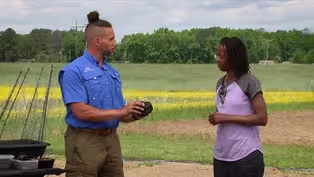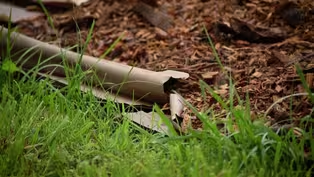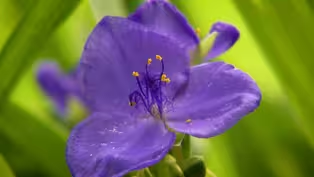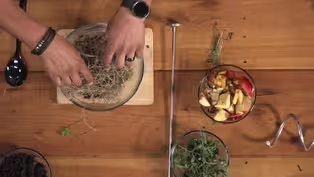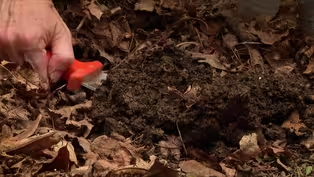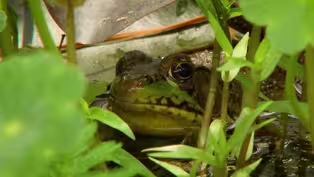Virginia Home Grown
Persimmon tree care
Clip: Season 24 Episode 3 | 6m 18sVideo has Closed Captions
How to pot up a young tree and encourage vertical growth
Andrew Freiden, 12 On Your Side Meteorologist, demonstrates how he grows native Virginia persimmon trees from seed and trains them for vertical growth to have strong healthy trees when it is time to plant in the ground. Featured on VHG episode 2403; May 2024.
Problems playing video? | Closed Captioning Feedback
Problems playing video? | Closed Captioning Feedback
Virginia Home Grown is a local public television program presented by VPM
Virginia Home Grown
Persimmon tree care
Clip: Season 24 Episode 3 | 6m 18sVideo has Closed Captions
Andrew Freiden, 12 On Your Side Meteorologist, demonstrates how he grows native Virginia persimmon trees from seed and trains them for vertical growth to have strong healthy trees when it is time to plant in the ground. Featured on VHG episode 2403; May 2024.
Problems playing video? | Closed Captioning Feedback
How to Watch Virginia Home Grown
Virginia Home Grown is available to stream on pbs.org and the free PBS App, available on iPhone, Apple TV, Android TV, Android smartphones, Amazon Fire TV, Amazon Fire Tablet, Roku, Samsung Smart TV, and Vizio.
Providing Support for PBS.org
Learn Moreabout PBS online sponsorshipWell, Andrew, rumor has it that you love persimmons.
>>My wife and kids right now, when the word persimmon comes up.
>>Yes.
>>They go, "Oh my gosh."
And just like, they go, and they're like, "We've heard this lecture enough times."
But they've actually kind of gotten into it.
They understand what's so great about this tree, which isn't a part of most people's landscapes.
>>No, they aren't because people just think of apples and other fruits and even nuts and such.
>>And it's a tree that's like, I hear from old timers, let's say.
>>Yeah.
>>They're like, "Well, I grew up on a farm out in the country and in the winter, that was our candy.
We'd go off into the woods and we'd eat this like dried wrinkly fruit."
Super sweet.
We have to spit the seeds out, but it's like, I kind of feel like I'm tied into the history of this land.
This tree's been here for thousands of years.
>>Yes.
Well, it is Diospyros virginiana.
>>That's right.
>>Our native persimmon tree.
>>It's right in the name.
>>And you've got one here, and I understand you grew it from seed.
>>So this, I found the seeds from... We found a couple trees in some neighborhoods in Chesterfield County.
>>Cool.
>>A couple wild persimmon.
>>Great.
>>So this is-- >>Ecotype.
Good job.
>>I think, yeah.
I mean, it's just nearby.
This is from very close by.
So this is a tree that is...
This is a tree that is I think three years old.
>>Okay.
>>So what we did is we got the seeds from the fruit.
>>Right.
>>We cold stratified it.
Do you want to tell people about that?
>>Well, it's just giving it a cold period to allow that seed to rest, to actually get its winterization so that when the warmth comes, it can germinate and grow.
>>Yeah.
And it basically is.
We mirrored at home what happens in nature.
It just sits on the ground somewhere or... >>Yeah, put it in the freezer.
>>An animal takes it somewhere, if you know what I'm saying.
Then it gets planted.
>>And it gets scarified anyway.
>>What?
>>When it goes through the gut.
Anyway, we won't go through that.
>>But I'm gonna google that when we get home.
That's two things you're making me google.
All right, so it's now time to take this guy.
And I think we need to put it in a bigger pot.
>>Good.
Let's do it.
>>All right, so this is my... And I think this process, we did a couple of these this afternoon.
>>So you've got some soil in here already.
>>And you can see that it is kind of root bound.
I don't know which, if I'm on the right camera there, but there's some, so we kind of had to work our way, kind of like pushing and pulling.
>>And I love how you reused pots.
>>Oh yeah.
are, I think these are pots from our... >>Oh, come on, I don't wanna mess this up 'cause it is kind of stuck in, >>Oh, there you go.
>>There we go.
It's okay.
>>Is there a cleanup crew here?
>>Yes, there is.
>>Should we show that?
But you can see, there's some pretty decent roots.
>>Got some nice roots in here.
Really nice ones coming along.
>>And then just break that up a little bit.
It's about the right... >>Yeah, break it up a little in the pot.
>>Break it up more in the... Like this?
>>Yeah.
>>Should I try to drop the level down a little?
>>It might, yeah, but massage it a little so the roots break on.
There you go.
All righty.
>>And then this is just clean up on aisle three.
>>Yes.
>>But so obviously, if we were at home, we would... >>Be watering in between.
>>We'd water this.
>>Yes.
>>And I'll do this when I get home.
>>Yeah, and we wanna make sure that we don't raise the level.
We wanna keep it at at the original level.
But if you were at home also, you wanna chunk it with your fingers to get that soil down along that side.
>>To fill in the holes.
>>Yeah, to fill in the holes.
>>We'd water this.
So you would also, I want this to grow a strong central stem because I don't want it to kind of be a bushy, I want it to be a tall and proud persimmon.
And so you're gonna help me do that, right?
>>Yes, I am.
>>Because I have total imposter syndrome.
This is the first time that I've done this or the first year we tried it but we want this guy to be... >>Easy, easy, go easy.
(Peggy laughing) >>Yah?
>>Don't bend so fast.
>>Okay, so we have a little stake here.
>>So we have easy tools here.
We have a nice strong stake and we have fasteners.
And it can be zip ties, it can be string, whatever.
>>I'm just gonna stick it right down in there.
>>Right, and you wanna put the stake right next to the trunk, and put it in there.
All the way down.
Yep, so it's good and sturdy.
And then what we wanna do is trees have an apical dominance.
That top bud.
>>That's this guy right here.
>>Yep.
And we want to now take this and tie this trunk, starting at the bottom and going up.
>>Okay.
>>So that we are-- >>And not too tight, but not too loose.
>>Snug.
How about that for a good word?
Okay?
>>And this is just some twine.
I'm not counting on this lasting more than or needing it more than a year.
>>Right.
It's all you're gonna have.
>>Right about here?
>>Right about here.
And don't get anal and pull it all the way in to make it perfectly straight.
It's a tree and it's been growing a little, you know, catawampus for its whole life.
So we can't make it a perfect straight stick, okay?
And then we wanna get this one up here.
So why don't we put one right there?
>>Right above this or below?
>>Yes.
Right above.
And what we're doing, we're incrementally tying it.
>>How're we doing on time, Peggy?
>>We're doing great.
>>Okay.
>>We're doing great.
And now comes the tricky part because we have to gently.
We don't move it fast.
We have to gently pull this up to here to tie it up here before we do the final tie.
Now, you have to realize this is a... You know, the branches have forked.
So we've gotta pick the best one, the one that has a nice strong leaf pattern, good space between the branches.
Very healthy tree, Andrew.
I'm very impressed.
>>Thank you.
>>And a nice clean bud.
So I'm gonna tell you to pick the left side 'cause the right side's a little gnarly, a little twisted.
>>I was talking with my daughter about this today.
You're telling me that whichever one we decide will literally become the trunk of the tree?
>>Will become the new.
Right.
>>That's so cool.
And you want this one?
>>Yes.
>>I wasn't listening.
I was working.
Sorry.
>>Plants have hormones and it's the growth hormones and most plants, it's at the tip of the top bud.
And then from there, if you lose that top bud, it'll branch out.
Some plants, like on determinant tomatoes, will naturally just grow one stalk where your indeterminate tomatoes or your bushy tomatoes, vine-y tomatoes have many, many branching vines coming off of it.
But right now, we're gonna have this be that new top or dominant bud.
>>I brought my scissors.
>>Good.
Make it pretty.
>>No, but you said not to.
Should I?
>>Don't prune anything?
>>Yeah, don't cut anything off.
>>Don't cut anything.
Just give it about six to nine months.
>>Okay.
>>Then you can take it apart.
>>And then I'm gonna put it in the ground.
This fall's my plan.
You think it's about time for these to go in the ground?
>>I think it's definitely time for these.
>>And when I talk to people about persimmon, I tell them they were meant to be in your soil.
>>Yes.
>>In your garden.
>>Yes.
>>You put 'em in and you don't really have to do a whole lot to them.
They are really strong, vigorous, healthy plants and they like it right here in Virginia.
>>Exactly, and the key is do not harvest them until after a good strong frost.
>>Oh, do we have time to talk about that?
>>No, we don't but I just wanna give everybody that thing.
>>Don't eat a persimmon unless it's really wrinkly, the native persimmons or it is a miserable experience.
>>Absolutely, but this has been a good one.
Thank you, Andrew.
>>All right.
Are you throwing a commercial now?
Video has Closed Captions
Clip: S24 Ep3 | 8m 40s | Learn about a amendment made with activated charcoal to improve soil health and structure (8m 40s)
Cardboard for suppressing weeds
Video has Closed Captions
Clip: S24 Ep3 | 2m 48s | Create a weed barrier in your garden by reusing cardboard packaging (2m 48s)
Video has Closed Captions
Clip: S24 Ep3 | 26m 46s | Healthy gardens are more than plants! (26m 46s)
Video has Closed Captions
Clip: S24 Ep3 | 6m 42s | How to make your own compost at home (6m 42s)
Video has Closed Captions
Clip: S24 Ep3 | 3m 23s | Maintain soft and fertile soil in raised bed gardens (3m 23s)
Transforming a traditional landscape
Video has Closed Captions
Clip: S24 Ep3 | 7m 53s | Adding native plants, reducing runoff, and improving soil creates an eco-friendly garden (7m 53s)
Providing Support for PBS.org
Learn Moreabout PBS online sponsorship

- Home and How To

Hit the road in a classic car for a tour through Great Britain with two antiques experts.












Support for PBS provided by:
Virginia Home Grown is a local public television program presented by VPM
